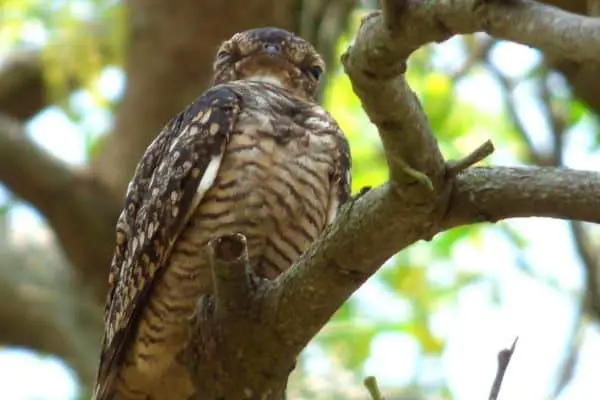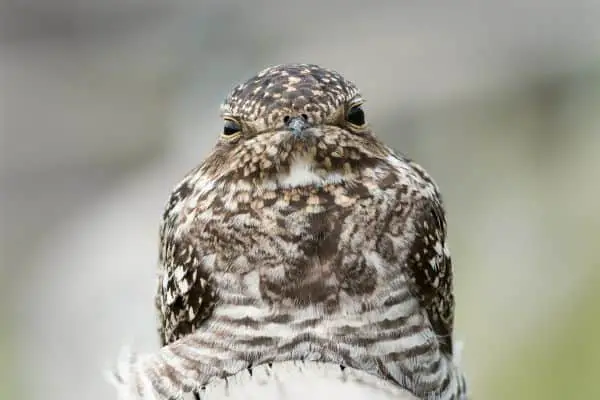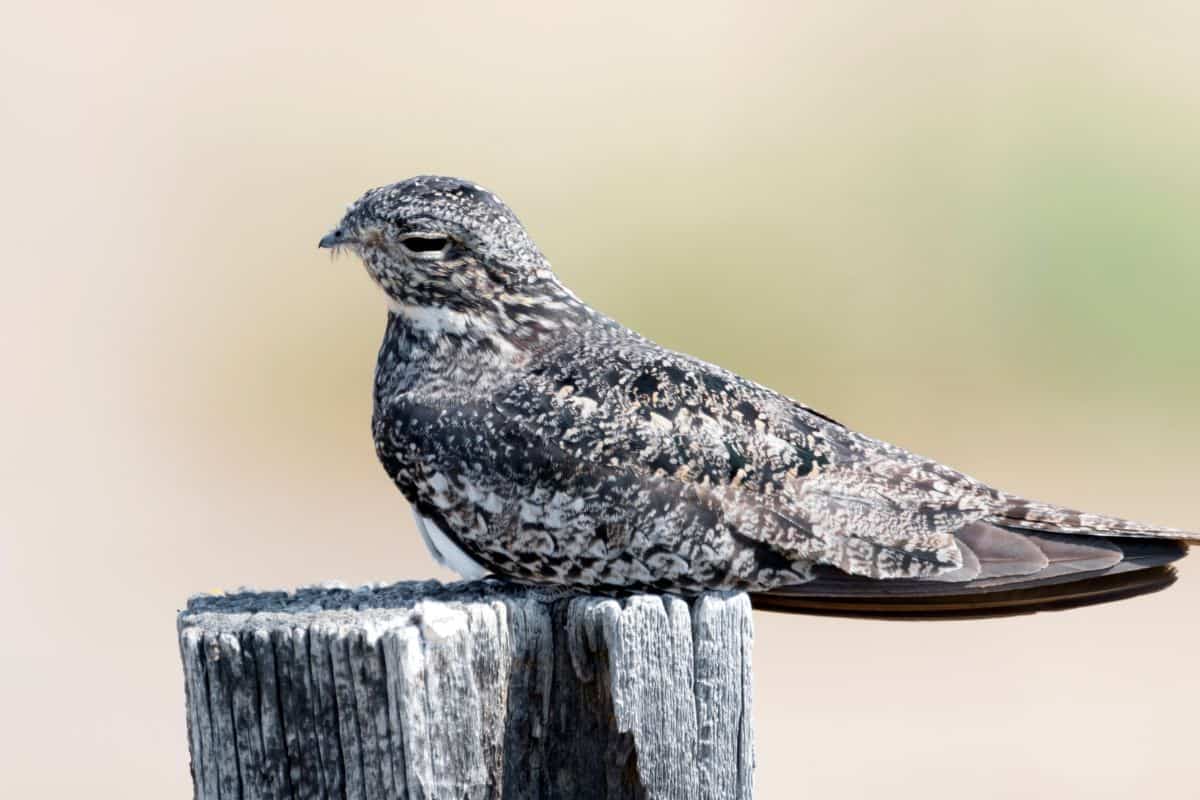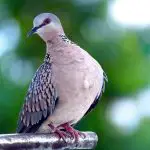Common Name: Common Nighthawk
Scientific Name: Chordeiles minor| Size | Diet | Range in Hawaii | Status in Hawaii |
|---|---|---|---|
| 8.5 in - 10 in. | moths, beetles, mosquitoes, and flying ants | Unknown | Least Concern |
The Common Nighthawk (Chordeiles minor) is a fascinating bird species known for its unique aerial acrobatics and distinctive call, which sounds like a nasal “peent.” These birds are found throughout North and South America during their breeding season and are often seen darting through the sky in search of insects to feed on.
While they are not known to breed in Hawaii, they have been spotted as non-breeding visitors and vagrants in the state during their migration season. With their impressive aerial displays and unmistakable call, Common Nighthawks are a favorite among birdwatchers and nature enthusiasts.
However, like many other bird species, they face threats from habitat loss and pesticides, making conservation efforts crucial for their survival. In this article, we will explore the fascinating world of the Common Nighthawk and the importance of protecting this beautiful species, even in places like Hawaii where they are only visitors.
Common Nighthawk
Appearance

The Common Nighthawk is a unique bird with distinct characteristics. It has a mottled brown and gray plumage that helps it blend seamlessly with its surroundings. With a slender body and long pointed wings, it possesses an agile and aerodynamic shape.
The Common Nighthawk has a wingspan of around 22 to 24 inches (56 to 61 centimeters) and measures approximately 8.5 to 10 inches (22 to 25 centimeters) in length. Its large eyes and wide mouth contribute to its excellent nocturnal vision and insect-catching capabilities.
Diet
The Common Nighthawk has a varied and insect-based diet. As primarily nocturnal hunters, they feed on a wide range of flying insects such as moths, beetles, mosquitoes, and flying ants. They are particularly skilled at capturing insects while in flight, using their agile flight and wide mouths to snatch prey from the air.
Common Nighthawks are known to feed on the wing, often foraging at dusk and dawn when insects are most abundant. Their diet is exclusively composed of insects, making them valuable contributors to natural pest control in their habitats.
Nesting
The Common Nighthawk has a unique nesting behavior. Instead of building nests, they lay their eggs directly on the ground or on flat surfaces such as gravel rooftops, bare soil, or rocky ledges. They prefer open areas with minimal vegetation, where their well-camouflaged eggs and chicks are protected from predators.
The female typically lays one or two eggs, which are incubated by both parents for about three weeks. Once hatched, the chicks are precocial, meaning they are relatively independent and can move around shortly after hatching. Common Nighthawks are known for their cryptic nesting strategy, relying on their excellent camouflage and their ability to remain motionless to avoid drawing attention to their nests and young.
Behavior

The Common Nighthawk exhibits fascinating behaviors that are adapted to its nocturnal lifestyle. As primarily crepuscular and nocturnal birds, they are most active during dusk and dawn.
During these times, they engage in aerial displays known as “booming” or “booming dives,” where they dive rapidly towards the ground while producing a distinctive booming sound with their wings. These displays are believed to be territorial and mating behaviors.
Common Nighthawks are highly skilled aerial hunters. They have a unique flying style, characterized by swift and erratic flight patterns as they pursue flying insects.
Their wide mouths and long, pointed wings aid in their efficient insect-catching abilities. They are known to forage at various altitudes, from treetops to just above ground level.
During the day, Common Nighthawks typically rest and camouflage themselves on tree branches or other flat surfaces, relying on their mottled plumage to blend in with their surroundings and remain inconspicuous. Their cryptic coloring provides excellent camouflage and helps protect them from potential predators.
In addition to their aerial displays, Common Nighthawks also communicate using various vocalizations. Males produce a distinctive “peent” call during courtship displays, while both males and females emit a variety of vocalizations including short, nasal “kik” notes and soft churring sounds.
Habitat
Common Nighthawks can be found in a variety of habitats across their range. They are adaptable birds that inhabit open areas with sparse vegetation, including grasslands, meadows, savannas, deserts, and even urban environments such as parks, rooftops, and parking lots.
These birds are typically associated with habitats that offer ample foraging opportunities for their insect-based diet. They are often found near bodies of water, including rivers, lakes, and wetlands, where flying insects are abundant.
During migration, they may also frequent coastal areas and flyways. Common Nighthawks prefer areas with open skies and high perching spots, such as snags, tall trees, or utility poles, from which they can launch their aerial forays to catch insects.
Their cryptic plumage provides camouflage against the ground or tree branches during the day, helping them blend into their surroundings and remain inconspicuous. While they are adaptable in their choice of habitat, Common Nighthawks generally avoid densely forested areas, preferring more open and sparsely vegetated habitats that offer clear flight paths and easy access to their preferred prey.
Range
According to the Hawaiian Biological Survey, the Common Nighthawk is a vagrant non-breeding visitor to Hawaii. They have been spotted in the Northwestern Hawaiian Islands (NHWI) during their migration season, which typically occurs between May and September.
While they do not breed in Hawaii, their presence as visitors and vagrants adds to the diversity of bird species found in the state. However, it is important to note that Common Nighthawks, like many other bird species, face threats from habitat loss and pesticides, making conservation efforts crucial for their survival.
Conservation Status

The conservation status of the Common Nighthawk is currently assessed as “Least Concern” by the International Union for Conservation of Nature (IUCN). This classification implies that the species is not facing immediate threats to its survival and has a relatively stable population across its range.
While the Common Nighthawk is not currently considered globally threatened, it is important to note that localized declines in some regions have been observed. These declines can be attributed to habitat loss and degradation, primarily due to urbanization, agricultural intensification, and the alteration of open habitats. Additionally, the use of pesticides and insecticides may indirectly impact the availability of the nighthawk’s prey base.
Interesting Facts
1. Crepuscular specialists
Common Nighthawks are primarily crepuscular, meaning they are most active during twilight hours, at dawn and dusk. They have specially adapted eyesight that allows them to navigate and hunt efficiently in low-light conditions.
2. Aerial acrobats
These birds are skilled aerial hunters. They have a unique flying style, characterized by erratic flight patterns and quick maneuvering as they pursue flying insects. They can perform acrobatic dives and sudden changes in direction with remarkable agility.
3. Distinctive camouflage
With their mottled brown and gray plumage, Common Nighthawks possess excellent camouflage. When perched or resting on the ground during the day, their intricate patterns help them blend seamlessly with their surroundings, making them incredibly difficult to spot.
4. Enigmatic vocalizations
Male Common Nighthawks produce a distinctive “peent” call during their aerial courtship displays. This vocalization, often described as a nasal “peent” sound, is a characteristic feature of their breeding season.
5. They are not Hawk
Despite their name, Common Nighthawks are not hawks or raptors. They are actually nightjars, a group of nocturnal insect-eating birds.
Frequently Asked Questions
1. Are Common Nighthawks social birds?
Common Nighthawks are generally solitary birds, except during the breeding season when they form loose colonies. However, they may roost in small groups, especially during migration or in favored feeding areas.
2. Are Common Nighthawks related to owls?
While both Common Nighthawks and owls are nocturnal birds, they belong to different families. Common Nighthawks are part of the nightjar family (Caprimulgidae), while owls belong to the owl family (Strigidae). They have distinct anatomical and behavioral differences.
3. How do Common Nighthawks survive during the winter?
Common Nighthawks migrate to Central and South America for the winter season, where they find suitable habitats with abundant insect populations. They rely on these areas to provide sufficient food resources until they return to their breeding grounds in North America.
4. Are Common Nighthawks active in rain or bad weather?
Common Nighthawks tend to reduce their activity during inclement weather, such as heavy rain or strong winds. They may seek sheltered locations and wait for more favorable conditions to resume their hunting and other behaviors.

